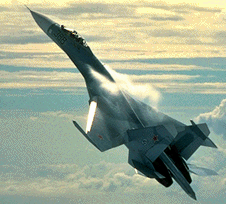Sukhoi Su-27 Flanker

Sukhoi Su-27 Flanker
Role:
Single-seat all-weather air-superiority fighter and
single/two-seat ground attack aircraft; two-seat combat
trainer.
DESIGN FEATURES:
Developed to replace Yak-28P, Su-15 and Tu-28P/128
interceptors in APVO, and to escort Su-24
deep-penetration strike missions; requirement was
effective engagement of F-15 and F-16 and other future
aircraft and cruise missiles; exceptional range on
internal fuel made flight refuelling unnecessary until
Su-24s received probes; external fuel tanks still not
considered necessary; all-swept integrated mid-wing
configuration, with long curved wing leading-edge root
extensions, lift-generating fuselage, twin tail fins
and widely spaced engines with wedge intakes;
rear-hinged doors in intakes hinge up to prevent
ingestion of foreign objects during take-off and
landing; integrated fire control system with pilot's
helmet-mounted target designator; exceptional
high-Alpha performance; basic wing leading-edge
sweepback 42 degrees; no dihedral or incidence.
LANDING GEAR:
Hydraulically retractable tricycle type, made by
Hydromash, with single wheel on each unit; mainwheels
retract forward into wingroots; steerable nosewheel,
with mudguard, also retracts forward; mainwheel tyres
1300 x 350 mm, pressure 12.25-15.7 bars (178-227 lb/sq
in); nosewheel tyre 680 x 260 mm, pressure 9.3 bars
(135 lb/ sq in); hydraulic brakes with two-signal
anti-skid system; brake-chute housed in fuselage
tailcone.
POWER PLANT:
Two Saturn/Lyulka AL-31F turbofans, each 122.6 kN
(27557 lb st) with afterburning. Large auxiliary air
intake louvres in bottom of each three-ramp engine duct
near primary wedge intake; two rows of small vertical
louvres in each sidewall of wedge, and others in top
face; fine-grille screen hinges up from bottom of each
duct to shield engine from foreign object ingestion
during take-off and landing. Pressure or gravity
fuelling.
ACCOMMODATION:
Pilot only, on K-36MD zero/zero ejection seat, under
large rearward opening transparent blister canopy, with
low sill.
AVIONICS:
Track-while-scan coherent pulse Doppler
lookdown/shootdown radar (antenna diameter approx 1.0
m; 3 ft 4 in) with reported search range of 130 nm (240
km; 150 miles) and tracking range of 100 nm (185 km;
115 miles); infrared search/track (IRST) sensor in
transparent housing forward of windscreen; Sirena-3 360
degrees radar warning receivers, outboard of each
bottom air intake lip and at tail. Integrated fire
control system enables radar, IRST and laser
rangefinder to be slaved to pilot's helmet-mounted
target designator and displayed on wide-angle HUD;
autopilot able to restore aircraft to right-side-up
level flight from any attitude when 'panic button'
depressed.
ARMAMENT:
One 30 mm GSh-301 gun in starboard wingroot extension,
with 150 rds. Up to 10 air-to-air missiles in air
combat role, on tandem pylons under fuselage between
engine ducts, beneath each duct, under each centre-wing
and outer-wing, and at each wingtip. Typically, two
short-burn semi-active radar homing R-27R (NATO AA-10A
'Alamo-A') in tandem under fuselage; two short-burn
infrared homing R-27T (AA-10B 'Alamo-B') missiles on
centre-wing pylons; and long-burn semi-active radar
homing R-27ER (AA-10C 'Alamo-C') or infrared R-27ET
(AA-10D 'Alamo-D') beneath each engine duct. The four
outer pylons carry either R-73A (AA-11 'Archer') or
R-60 (AA-8 'Aphid') close-range infrared missiles. R-33
(AA-9 'Amos') missiles optional in place of AA-10s.
Five-round packs of 130 mm rockets, or larger rocket
pods, under wings in ground attack role.
Aircraft Measures:
Length: 71 ft., 11{1/2} in.
Height: 19 ft., 5{1/2} in.
Wingspan: 48ft. 2{3/4} in.
Loaded Weight: 67,240 lbs
Aircraft Performance:
Maximum Speed: mach 2.35
Service Ceiling: 59,055 ft.
Range: 2485 miles
Thrust: N/A
